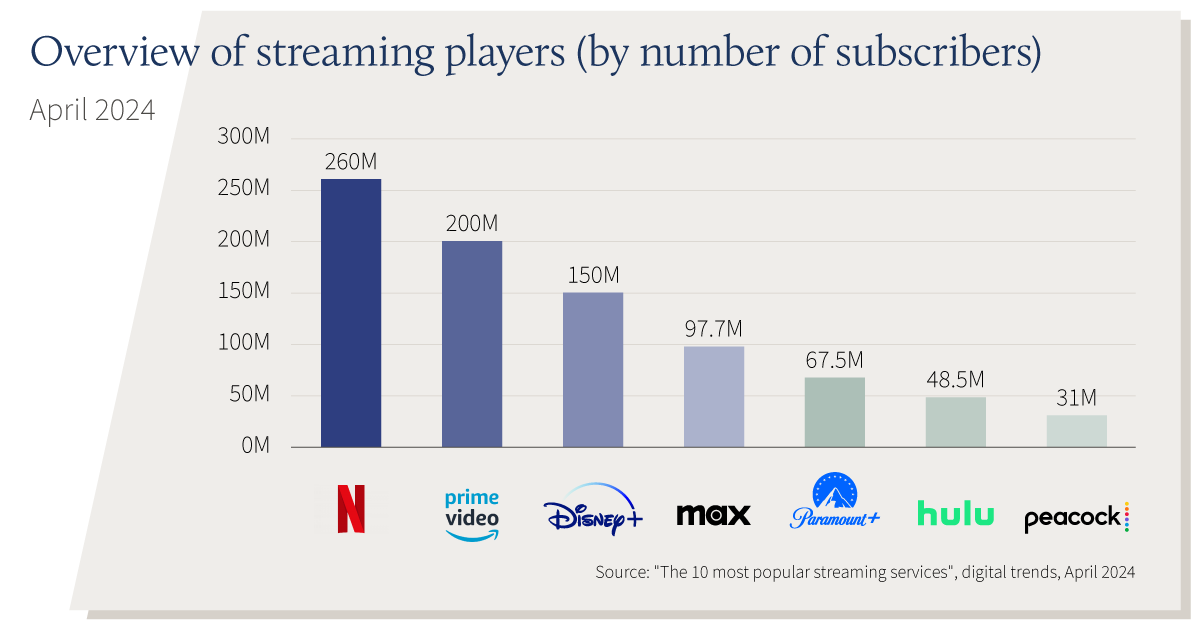The streaming market: challenged yet promising

With the projected revenue in the Video Streaming (SVoD) market expected to reach US$ 109 billion by 2024 (1), the streaming industry stands as a testament to modern innovation and consumer demand.
Discover the streaming market, how it has shaped our modern societies to become inescapable, its current challenges, and its promising potential in the next years to come.
An industry that has expanded to become almost inescapable today
A strong added value: globalisation and household penetration
In the ever-evolving Entertainment and Media (E&M) landscape, adaptability is paramount for sustained success. Streaming platforms have swiftly risen to prominence, captivating audiences worldwide: SVoD subscribers worldwide are projected to surpass 1.1 billion by 2024.[6]
The United States leads the charge, boasting the highest revenue in the E&M sector, with US$ 43.97 bn in 2024[7]. Streaming now surpasses traditional TV, claiming over 38% of total usage[8]. A remarkable 99% of US households subscribe to at least one streaming service[9] —a notable increase from 2015's 52%[10]. This rapid ascent underscores the widespread popularity and household adoption of streaming platforms in a remarkably short timeframe.
|
Some numbers
|
The streaming revolution: a multifaceted journey
Fueled by technological advancements and data-driven strategies, streaming platforms have revolutionized entertainment consumption.
► High-Speed Connectivity: Breaking the TV Shackles
With the widespread availability of high-speed internet and the ubiquity of mobile devices, consumers now enjoy unparalleled flexibility, breaking free from traditional TV schedules.
► Diverse Content Offerings
Beyond Passive Viewing. Additionally, the integration of new content formats such as gaming and live sports events not only enhances the user experience but also diversifies revenue streams for streaming platforms.
► Personalization through Data
Forging Deeper Connections. Furthermore, streaming platforms leverage sophisticated data analytics to curate personalized content, fostering deeper client engagement and loyalty. This era of personalization underscores the streaming market's appeal, promising continued growth and innovation as it delivers tailored, on-demand content experiences to audiences worldwide.
Challenges and strategies for success
► The competitive landscape - Navigating a crowded market
The streaming landscape finds itself in a state of saturation, marked by fierce competition that necessitates innovative strategies to sustain growth. This heightened competition is evident as new entrants continually disrupt the market with innovative business models. For instance, Disney+ has carved a niche with its focus on original content offerings, while services like Hulu have embraced an advertising-based approach to offer competitive pricing.

► Account sharing and revenue loss: balancing accessibility and profitability
Initially, streaming revenue relied on two main sources: increasing subscriber numbers or hiking subscription prices. This approach, exemplified by Netflix, proved effective for years. However, by 2022, Netflix faced subscriber losses amid rising competition. Thus, the issue of password sharing emerged as a critical concern, prompting efforts to convert 'sharers' into paying customers to ensure sustained profitability and growth.
► Subscription strain: navigating price sensitivity in the streaming era
In today's streaming landscape, companies grapple with profitability despite substantial content investments. The challenge stems from the high cost of producing original content and consumer resistance to price hikes. By 2024, Netflix emerges as a leader, capitalizing on scale and profitability. To retain subscribers amidst fierce competition, competitors must continue to innovate.
► Charting new paths: consolidation and mergers for survival
In response to heightened competition, companies may pursue consolidation to enhance scale, potentially through mergers and acquisitions (M&A) with former rivals. However, this path is rife with challenges, including cross-border regulations and anti-monopoly scrutiny.
► Regulatory headwinds: navigating data privacy and content licensing
As the streaming landscape evolves and new audiences emerge globally, the complexity of these developments may prompt the introduction of fresh regulations pertaining to data privacy and copyright protection.
The investor's guide: unlocking opportunities in the streaming sector
Despite the challenges the streaming industry faces, it still emerges as one of the most promising markets, with a projected Compound Annual Growth Rate (CAGR) of 8.27% from 2024 to 2027[15]. Looking ahead, the industry is poised for transformation, driven by several key factors:
► Harnessing the power of artificial intelligence and blockchain technology
Innovations in Generative Artificial Intelligence (AI) promise personalized content offerings and enhanced creativity. Moreover, AI and blockchain technology are revolutionizing video quality, with AI contributing significantly to editing, cinematography, voice-overs, scriptwriting, and various other aspects of production and upload.
|
Did you know?
|
► Advancements in 5G technology
The widespread adoption of 5G technology is set to elevate network quality, offering seamless streaming experiences and enhanced connectivity for users worldwide.
► Emergence of augmented reality and the metaverse
Augmented reality and the metaverse present exciting opportunities for immersive streaming experiences, blurring the lines between virtual and physical worlds.
► Increased active engagement and participation
Expect a surge in active engagement and real-time participation in the streaming realm, facilitated by a more interconnected cross-platform approach. Social media platforms are becoming primary avenues for discovering and engaging with entertainment content, fostering a dynamic streaming ecosystem.
► Promising growth in emerging markets
While global prospects remain robust, particularly in Europe and Asia, emerging markets offer untapped potential for further expansion and innovation within the streaming industry.
Conclusion
The streaming market embodies a domain of vast opportunity amid rapid growth and innovation. Despite challenges like heightened competition and regulatory complexities, the industry thrives on adaptability and forward-thinking. With emerging technologies like AI, blockchain, and 5G, coupled with the rise of augmented reality and the metaverse, the future of streaming is ripe with potential. By embracing innovation, fostering collaboration, and prioritising customer-centric strategies, stakeholders can navigate this dynamic landscape towards sustained success and growth.
|
Addressing the challenge of the streaming market will require substantial investments and capital expenditures. The Investment and Portfolio Advisory team at Rothschild & Co Wealth Management has dedicated time and resources to analysing this market and is ready to advise you on investing in this long-term trend. For further information on how to invest in this sector please contact your client adviser. |
[1] [2] [3] [15] Video-on-Demand - Worldwide | Statista Market Forecast
[4] [9] [11] [12] [13] 2024 Media Streaming Stats You Should Know – Forbes Home
[5] [7] Video Streaming (SVoD) - US | Statista Market Forecast
[6] [10] [16] [17] Video Streaming Services Stats (2024) (explodingtopics.com)
[8] Streaming has surpassed cable as America's most-watched viewing platform (nbcnews.com)
[14] Most expensive countries to get Netflix worldwide 2023 | Statista